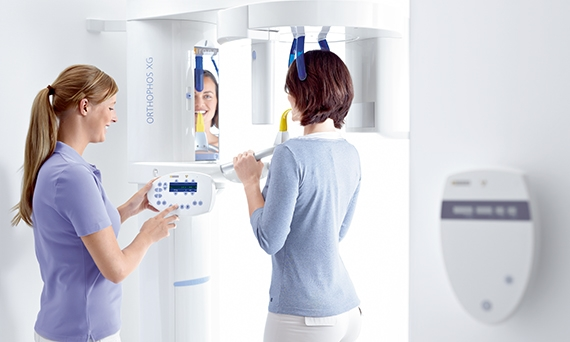3D X-ray

In order to provide our patients with advanced, reliable and highest possible quality services, from now on we use in our Clinic modern Sirona Orthophos XG 3D machine produced in Germany for 3D imaging. The image is taken quickly and safely, and with the minimal dose of ionizing radiation. Where a panoramic X-ray is taken, radiation flux is up to 25 microsieverts (0.025 mSv), i.e. about 100 times smaller than, e.g., by performing the head computed tomography, and taking a 3D X-ray – about 100 microsieverts (0.1 mSv). After this diagnostic test, doctors get very accurate, undistorted and real images of the upper and lower jaws and the surrounding areas (i.e. sinus, mandibular joints, respiratory tract) because by performing 3D X-ray about 200-500 images are produced. The image of each patient is automatically stored in our computer database, so it can be easily and quickly accessible at any time. At the patient’s request, the image can be recorded on CD or printed. In our Clinic 3D X-rays are performed • during planning of implant procedures; • prior to bone augmentation and sinus lift surgery procedures. A 3D image in planning the implant surgery procedure before the start of treatment allows choosing implants accurately; in addition it also helps to determine the most appropriate location and direction of the restorations. Based on these data, a precise surgical guide can be produced according to which planned surgical treatment is carried out accurately, quickly and comfortably, and with minimal damage. 3D X-ray enables physicians • to clarify the diagnosis; • to create an optimal treatment or restoration plan; • to control the course of treatment; • to avoid inaccuracies in implant positioning during surgery; • to evaluate in great detail teeth, their roots, hard tissue around the teeth, alveolar process of the jaws, the lower jaw joint, nerve and vascular status, and the maxillary sinuses.
We offer Ivoclar Vivadent crowns, veneers, inlays, onlays produced from lithium disilicate blocks (e-max CAD). Tensile strength of teeth made of these units is 360 MPa, i.e. twice higher than that of conventional units and four times larger than ceramic used for decoration on metal. Teeth made from these blocks are initially slightly bluish, their resistance is up to 160 MPa, and they can be measured in the mouth. After about 30 minutes of crystallisation in an oven, they obtain proper colour and flexural strength of 360 MPa. There is no need to fix restorations made of e-max by adhesive systems; they can be cemented using conventional dental cement. This saves time, and aesthetic qualities of lithium disilicate ceramics are the same as ceramics of other types.